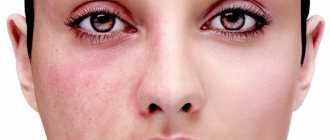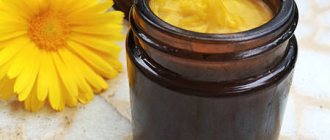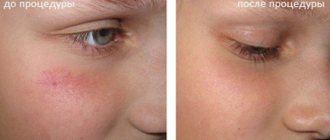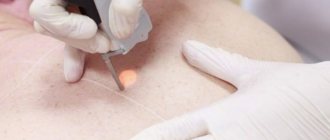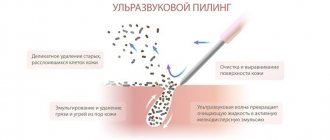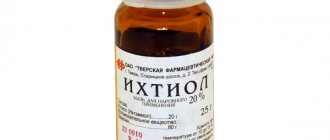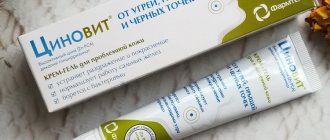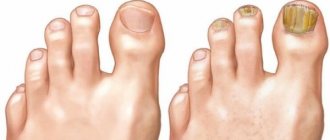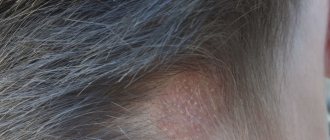The human body is penetrated by a complex network of vessels, the total length of which in the body of an adult is approximately 100 thousand kilometers.
Unfortunately, with age and due to various diseases, blood vessels become more fragile, lose their elasticity, and cease to function normally. When this happens, it is customary to say that the patient has some kind of vascular disorder.
Complex cases are entirely the domain of phlebologists (from the Greek phlebos (vein) and logos (knowledge)), while dermatocosmetologists can work perfectly and effectively with milder manifestations of vascular disorders with the modern development of hardware cosmetology.
Why does rosacea appear?
The main causes of facial skin changes and broken capillaries are skin aging, sun damage, chronic inflammation, hormonal changes , skin characteristics and heredity:
- excessive exposure of the skin to UVA rays from the sun,
- sudden changes in temperature,
- aging, thinning facial skin,
- inflammatory diseases of the facial skin,
- injuries, damage to the face, including operations,
- hormonal changes, such as pregnancy, menopause or puberty,
- excess weight,
- liver damage and chronic diseases,
- hereditary factors and a number of others.
Heredity, aggravated by age, inflammatory diseases, and skin lesions, is one of the most common causes of facial rosacea.
As you age, your skin becomes thinner as collagen and elastin production decreases.
Inflammatory diseases such as rosacea and acne also provoke the appearance of spider veins on the cheeks and wings of the nose. But intensive cosmetic procedures can also affect the development of the disease.
The development of rosacea can be enhanced by drinking alcohol , smoking and liver damage. As a result, the capillaries become especially clearly visible.
It has been noticed that people with fair skin, as well as thin, sensitive, dry skin are more susceptible to rosacea. More often it occurs in women (which is associated with the female hormonal system).
Visible vessels: causes of their occurrence and types
Telangiectasias are visible vessels of the capillary network, the diameter of which does not exceed 1 mm. Both arterial and venous vessels can dilate. Venous ones are more noticeable because they are bluish and rise above the skin.
Arterial ones are also easy to recognize: they are no more than 0.1 mm in diameter and have a bright red color. Telangiectasia can be located in different parts of the body, but arterial ones are more often localized on the neck and face, and venous ones - on the lower extremities.
Based on clinical observations, visible vessels can have different shapes. Based on this feature, they are divided into punctate, tree-like, linear and stellate (spider veins).
Doctors say that visible vessels tend to be inherited. In addition, the influence of endogenous and exogenous factors on the body has an impact.
Endogenous factors:
- Violation of venous outflow;
- Liver diseases;
- Lipofibrous degeneration of subcutaneous fat;
- Problems with blood clotting;
Exogenous factors:
- Frostbite of the skin;
- A course of radiation therapy;
- Excessive insolation;
- Use of steroid hormones;
- Deep skin peeling;
- Surgical trauma.
Methods for removing vascular network
The most effective and efficient way to get rid of spider veins is with laser treatment. Although there are other methods for correcting the skin.
Types of methods for removing spider veins:
- Sclerotherapy – a special drug is used that simply “glues” the vessels together and is used when pathology occurs in the lower or upper extremities.
- Electrocoagulation - the affected area is exposed to a device that uses electrical impulses.
- Radio wave surgery is a non-contact way to remove spider veins
- Laser photocoagulation is the most effective method in modern hardware cosmetology, which actively fights rosacea and causes virtually no unpleasant consequences.
All these methods are almost the same in cost, but radio wave surgery and laser therapy are the most effective and painless. With laser photocoagulation, spider vein removal occurs quickly and has a fairly long-lasting effect. Currently, this procedure is popular and in demand among visitors to beauty salons and aesthetic medicine clinics.
Principles of treatment of rosacea
If you have a tendency to rosacea, you can prevent its occurrence or reduce the influence of factors on its development. Prevention is an important point in the fight against rosacea, which cannot be ignored, because without it and comprehensive treatment, this disease will manifest itself more and more with age due to thinning of the skin. The main goal of preventive and therapeutic actions is to strengthen the walls of blood vessels, regulate pressure in the vessels, optimize microcirculation, and as a result, prevent the formation of visible vessels (telangiectasia), and remove external manifestations of rosacea.
The main methods of treating rosacea:
- medicinal,
- surgical.
Also, in a number of cases, folk remedies have proven themselves well. However, it should be noted that folk remedies can be used as an addition to the main methods of treatment and prevention and in no case replace them. It is also worth noting that many doctors do not have experience and a treatment program for rosacea, which is why they prescribe folk remedies, ignoring other methods of getting rid of this disease. You can hear advice to apply grated potatoes, make lotions from tea or brewed chamomile, even from candidates of medical sciences.
I was very worried about rosacea on the wings of the nose, which appeared during pregnancy. The doctor advised taking rutin to strengthen the walls of blood vessels, and also making lotions with green tea .
Marina K.
In this case, it makes sense to think about another doctor, so as not to miss precious time and not trigger the disease.
Preventive actions
Unfortunately, there are precedents for the recurrence of the disease after laser correction. To prevent them, it is necessary to determine the factors that led to the occurrence or intensification of rosacea, and then eliminate them. If the exact risk factors are not identified, general preventive recommendations should be followed:
- Do not overdo it with tanning and use sunscreen before going outside.
- Do not steam your face, reduce visits to steam rooms and baths.
- Take vitamins containing ascorbic or nicotinic acid to strengthen the walls of blood vessels.
- Adjust your diet (abstain from canned food, sweets and alcohol).
- Avoid sudden weight fluctuations.
- Spend time outdoors more often, provided you use protective cosmetics from ultraviolet radiation, and practice moderate physical activity.
- Avoid skin care cosmetics containing honey, menthol or alcohol.
- Do not carry out aggressive chemical cleansing and peeling, as well as any other procedures among the contraindications that include rosacea.
- Use creams to prevent rosacea (only as prescribed by a doctor).
Results of the procedure
After photocoagulation, slight swelling and redness may remain in the treated area, and blisters may appear. These symptoms will go away on their own within a few days. To quickly restore the skin, doctors recommend:
- Immediately after therapy, cool the affected area - you can use an ice pack.
- Apply antibacterial ointment for a week.
- Use healing ointments up to 5 times a day, for example Bepanten.
- Do not wet the treated areas and refrain from wearing makeup.
- Protect your skin from sunlight for 3 months to prevent pigmentation.
- Refrain from visiting baths and saunas.
It is important to avoid tearing off the crusts to avoid scar formation; during the period prescribed by the doctor, wear compression socks or stockings if spider veins on the legs or arms were removed. Avoid heavy stress on the venous system (sports).
For better skin restoration, doctors recommend applying antibacterial ointment for a week.
This method of correcting vascular formations on the face is considered the safest and least traumatic. Therefore, healing of the skin after the procedure occurs in the shortest possible time and gives good results.
Causes of the problem
Vascular disorders can be congenital (genetic predisposition), may occur due to cardiovascular and other diseases, as well as due to hormonal imbalances. For example, in women, visible blood vessels may appear during pregnancy and after childbirth. An unhealthy lifestyle (overweight or obesity, alcohol abuse, nicotine), prolonged exposure to direct sunlight, excess ultraviolet radiation, sudden climate changes and other risk factors can possibly weaken the walls of blood vessels and expand their diameter.
Even if vascular lesions do not create serious health problems and do not interfere with the body's normal functioning, they can reduce a person's quality of life due to cosmetic defects. Thus, spider veins and pronounced port-wine stains on open areas of the skin, and even more so on the face, upset patients and undermine their sense of self-confidence and attractiveness. Therefore, correction of visible vascular disorders listed above is an important task for a dermatocosmetologist.
Liliana Myslovich, Associate Professor, Department of Dermatology, RUDN University, Medical Director of Alma Lasers:
“The competence of a cosmetologist includes providing services for the correction of telangiectasia with a diameter of up to 1.2 mm, removal of arachnid and capillary hemangiomas (“cherry vine”), treatment of rosacea and rosacea. A vascular surgeon can work with the entire spectrum of vascular pathologies.”
Drug treatment of rosacea
Foreign dermatologists have developed a current scheme for the prevention and treatment of rosacea. It is aimed at:
- preventing the formation of new dilated capillaries,
- reducing the visibility and redness of existing broken capillaries,
- tightening the facial skin, increasing its resistance to damage.
If necessary, this method is also a preparation for laser treatment of rosacea, since after it the likelihood of pigmentation and redness of the skin after surgery is reduced.
What is used in the treatment of rosacea with medications ? First of all this:
- skin cleansing with topical application of vitamin C and sunscreen with a high degree of protection against UVA rays,
- the use of creams with retinol, isotretinoin and other vitamin A derivatives.
Troxevasin cream, which contains vitamin P - rutin, has proven itself very well. Rutin reduces vascular permeability and improves blood microcirculation.
In combination with the intake of vitamins A, C and K, troxevasin showed very high effectiveness in affecting the vascular network.
Also, good results can be observed after using heparin ointment, special creams with an anti-rosacea effect (which include collagen, rutin, as well as blueberry, butcher's broom, myrtle, and grape seed oil extracts). ascorutin and retinol have a similar strengthening effect on capillaries . Retinol today is perhaps the main anti-aging agent, which not only reduces the visibility of broken and dilated capillaries, but also improves collagen synthesis, thereby reducing the appearance of new problems with capillaries.
Despite the fact that drug treatment is the simplest, most accessible and cheapest way to combat burst blood vessels on the skin of the face, it is effective only in the initial stage of rosacea, while the vascular network is not yet clearly expressed. In most cases, such treatment is aimed only at eliminating the external manifestations of the disease and does not affect the cause of its occurrence.
How is rosacea eliminated?
One of the most common and most effective ways to correct this disease is to remove spider veins with a laser (laser photocoagulation). This method is aimed at absorbing a concentrated stream of light into the vessels, resulting in their sealing. Moreover, there is no effect on surrounding tissues. After this, blood stops flowing into the capillaries, and they disappear or become lighter.
Before starting the procedure, the doctor individually selects the intensity of laser irradiation, taking into account the location of the affected vessels on the face. Only after all the settings have been accurately set, the specialist proceeds to eliminating the defect. Removal of spider veins on the face occurs as follows:
- The laser impact area must be treated with anesthetics. If a person has a low pain threshold or plans to remove large vascular dilations, then in these cases local anesthesia is used. Before starting the operation, the patient must wear special protective glasses over his eyes.
- Each vessel is treated individually with a laser beam - from the thinnest parts to the wider ones. This continues until the capillary disappears completely or turns light purple, which is normal for thick stars. Laser treatment can also be carried out in a point-by-point manner, the distance between them should be from 0.5 to 1 mm. The radiation power for the face area corresponds to 0.9 - 1.2 W, duration - 0.2 seconds. If removal of spider veins and mesh on the legs is required, then laser irradiation will be equal to 1.2 - 1.7 watts and 0.4 seconds, respectively. During the session, the patient will not feel any pain or discomfort. Only a slight tingling sensation may be felt at the removal site.
- Upon completion of therapy, the skin is cooled to 4–7 degrees. This will prevent burns and reduce pain. Exposure to cold is used by different methods - a flow of cold air, the use of sapphire glass together with cooling gas, as well as gels and sprays.
During the procedure, the doctor acts on each vessel separately.
The therapy session lasts about 20 minutes, the next operation can be performed only after 2-3 months. It should be noted that laser can only eliminate such types of vascular pathologies as stars and meshes, as well as punctate hemangiomas. Different types require individual time and number of sessions. It happens that the defect disappears after the first exposure, but more often than not, a single laser irradiation does not completely remove the vascular networks and asterisks. The number of sessions is influenced by the depth and thickness of the vessel that needs to be removed. The larger and deeper it is, the longer it will take to eliminate it.
Laser for removing blood vessels on the face and body - types, rating of the best devices
The vascular laser quickly and non-traumaticly removes meshes and stars from any area of the skin. The doctor selects the type of installation and adjusts the parameters depending on the size of the formation and its depth.
The device for removing blood vessels is safe for health and has a targeted effect. The principle of its operation is radiation, which heats the blood and evaporates it.
The vessel stops receiving nutrition, “sticks together” and completely disappears or significantly decreases in size. The remaining areas remain untouched. The doctor sets the permissible frequency of exposure, so the tissues are not injured.
The procedure is virtually painless due to the cooling system that all modern units are equipped with. Removal of blood vessels with a laser on the face, neck or body is carried out as follows:
- The client wears goggles to protect their eyes from flashes.
- The skin is treated with an antiseptic and light-conducting gel.
- The doctor directs the beam to the area with the vascular network or asterisk.
- A soothing cream is applied to the face.
The number of outbreaks depends on the size of the defect and the degree of blood filling. Minor damage disappears in 1-2 sessions. Large stars will require 3-4 procedures. To restore the skin, you need to buy Panthenol cream and apply it several times a day until complete healing.
The main difference between laser systems is the wavelength, which determines the depth of impact.
Diode laser for vessel removal has a minimum of contraindications and side effects. The device is a semiconductor device. It does not leave burns and is suitable for any skin type and people with a low pain threshold.
The wavelength depends on the type of diode device: from 375 to 3330 nm (nanometers). But to eliminate formations, 800-810 nm is enough.
Vascular diode lasers can remove deep-seated defects of any size. The result of the procedure is noticeable after 2 weeks.
Neodymium lasers for removing blood vessels on the face and body generate a wavelength of 1065 nm. The installation is suitable for eliminating defects at a depth of up to 5 mm. It is equally effective in coagulating red and blue lesions of any size.
Most often, the device is used to get rid of vascular networks on the lower extremities. It will not be possible to clean the wings of the nose due to noticeable discomfort.
When removing blood vessels with a neodymium laser, you do not need to take into account your skin phototype. It suits everyone. But if you set the wrong parameters, there may be consequences in the form of changes in skin pigmentation and scarring.
This type of laser equipment generates waves with a length of 755 nm. The Alexandrite device can remove blue blood vessels on the legs. But it is not suitable for naturally dark or tanned skin due to the risk of severe burns.
The disadvantage of the device is the short pulse. To remove large formations, you will have to set the power to high. But in the last 5 years, devices with pulse lengths of up to 200 ms have appeared on the cosmetology market.
For alexandrite lasers, the light spot has a diameter of up to 18 mm. One flash is enough to cover a large area.
The laser is used to treat point lesions - hemangiomas, angiomas. The operating principle of CO2 devices is based on mixtures of gases: carbon dioxide, helium, nitrogen, xenon, hydrogen. They emit powerful waves that evaporate the blood and eliminate the vessel.
The laser device generates waves with a length of 10,600 nm. The devices are suitable for treating deep-lying vessels.
The CO2 installation is considered the most “hard” of all known laser systems. It severely damages tissue and is not suitable for dry skin because it reduces oiliness.
The IPL laser emits broadband pulsed light from the vessels. The size of the light spot is 8×35 mm. The device is chosen if you need to remove many small formations at once.
The IPL device operates at higher energy and higher power than previous installations. Wavelengths from 530 to 590 nm. The device will not cope with deep rosacea, but it will help with superficial vascular networks.
The advantage of the installation is the low cost of treatment and a small number of procedures to achieve a visible result. The IPL laser is commonly used to remove blood vessels on the face.
Nd:YAG laser is another name for neodymium units.
The laser is used for superficially located vessels. It generates waves with a length of 585-595 nm. The most common dye is rhodamine. Manufacturers also use fluorescein, coumarin, and tetracene.
The FPDL laser for vessel removal cannot eliminate defects at a depth of more than 0.2 mm due to the high scattering coefficient. Also, it cannot be used on skin of the 4th and 5th phototypes due to the high risk of pigmentation.
The installation operates with high energy density. It is important not to overdo it when choosing the power of exposure, otherwise the built-in cooling will not save you from burns.
The pulsed laser system generates waves with a length of 511 and 578 nm. The doctor selects them using filters. In the first case, green spectrum light is emitted, which is suitable for treating pigmentation. In the second - yellow. It is used to correct blood vessels, treat post-acne and uncolored skin defects. The risk of scarring is minimal.
The device is only effective for correcting surface meshes. It will not cope with deep vessels and is not suitable for dark skin due to the possibility of the formation of dyschromia.
Let's look at the most effective and popular lasers.
The rating is topped by the Israeli M22 neodymium unit with a wavelength of 1064 nm. It can remove blood vessels and pigmentation, and is suitable for hair removal and photorejuvenation. Individual power is set for each patient. Therefore, the procedure is painless, and small meshes and stars disappear in 1-2 sessions.
M 22 heats the blood to 42 degrees and destroys chromophores. It is optimal for removing small superficial vessels and can even cope with old formations. The device can be used at any time of the year on skin of all phototypes.
Contact cooling with a sapphire tip eliminates burns after procedures.
The American BBL laser removes blood vessels and treats varicose veins using a non-contact method. The risk of burns and scars is minimized. To select the wavelength, you simply need to change the filters, rather than buying additional heads.
A thermoelectric cooling system is used, which prevents overheating of the epidermis. The exposure temperature can be selected down to one degree.
The BBL unit is equipped with 2 lamps for uniform treatment of the skin and has a high flash frequency. Vessels are removed almost painlessly even at minimum power.
) produces combined units: erbium and neodymium in one housing. They generate waves with a length of 2940 and 1064 nm. The equipment is used for FT laser removal of blood vessels on the face, hands and other parts of the body.
The Fotona laser procedure is painless and does not cause serious side effects. Maximum swelling and redness.
The units cope with vessels up to 2.5 mm in diameter. They completely go away after 2-3 weeks.
Candela Medical (not Candella) manufactures the VBeam Prima or VBeam Perfecta dye lasers. The installation treats dilated blood vessels. It is equipped with an integrated cooling system and several applicators of different diameters.
Vibim equipment from Candela is created on the basis of micropulse technology: each pulse is scattered into 8 small ones. The doctor regulates the amount of energy needed to remove the vessel. Therefore, the skin is less injured during the procedure, and the recovery period is reduced.
The top laser installations include American neodymium-type Cutera Xeo equipment. The device has several attachments and operating modes. The parameters are adjusted for each client depending on the severity of the defect. The procedure is carried out at any time of the year.
"Kuter" is suitable for all spectrums of vascular lesions of any location. The treatment can be carried out even on dry, sensitive and tanned skin.
The Viavens diode laser with a wavelength of 980 nm is considered universal. It is suitable for any area of the skin, copes with pinpoint vessels and extensive mesh. The installation also prevents relapse through the production of collagen and thickening of the epidermis.
The air cooling system minimizes pain. The laser is suitable for all phototypes and does not cause pigmentation, blistering or other skin damage.
Devices using Elos technology use light and radio frequency energy. They remove blood vessels and simultaneously stimulate collagen production. The equipment is non-contact and does not cause skin damage. The result is visible within a few days. Pink and red formations are removed faster.
On the laser, you can adjust the energy settings and use low power. The risk of burns, scarring and hyperpigmentation is minimal.
Elos installation copes with deep and superficial defects of any size. After the procedure, the skin turns red and swells moderately. But the side effects go away after 2-3 days.
There is a lot of debate about which laser is best to use to remove blood vessels on the face. When choosing a setup for a procedure, consider the following criteria:
- wavelength, pulse duration (if it can be adjusted, the laser will suit any phototype);
- number of contraindications and side effects;
- light spot size, power;
- energy density (the higher it is, the more painful the procedure);
- pulse resource (affects service life);
- presence of a cooling system, quality certificate.
Good clinics install several devices at once. They are selected depending on the depth of the vascular network, color and skin of the client. The deeper the formation lies, the longer the wave generated by the laser should be.
Laser therapy has a small number of absolute contraindications. Therefore, in clinics this method is used to eliminate hyperhidrosis, acne, stress urinary incontinence, and snoring.
Lasers are used to remove tumors, treat diseases of the brain, pathologies in the field of gynecology, cosmetology, cardiovascular, nervous and genitourinary systems, respiratory organs, skin, oral cavity, and gastrointestinal tract.
There are many positive reviews about the CO2 laser on cosmetology forums. Patients note that the procedure is quite painful, but very effective.
Girls also speak well of the copper vapor laser system. It removes superficial defects from fair skin in 1-2 sessions without side effects. The price is affordable, and the rehabilitation period takes no more than 2 weeks.
There are many enthusiastic comments about the D-LAS and Green Diode diode lasers. According to clients of the clinics, they can even cope with deep, old vessels. Although the recovery period is long. Those who violated doctors' recommendations and did not care for their skin at home were dissatisfied.
There are negative reviews about the removal of blood vessels with a neodymium laser. For some girls, the therapy did not help even after the 2nd time, although the formations were small. But doctors say that the device may be less effective due to the use of hormonal drugs.
Positive opinions are expressed about the Palomar Lux G (“Palomar”) laser. Commentators write that after one procedure the vessels go away. But for maximum effect, several sessions are required.
Did you like the article? Share with your friends!
Cosmetological treatment of rosacea
In beauty salons and clinics, facial rosacea is successfully treated using special products and devices. The following methods are used:
- cryotherapy,
- mesotherapy,
- application of microcurrents,
- electrocoagulation.
A method called ozone therapy . Using a thin needle, a mixture of ozone and oxygen is injected under the skin. In 3-4 sessions it is possible to completely get rid of rosacea. After this operation, scars and age spots do not form, the skin is quickly restored, and the results last a long time.
Another effective method is photocoagulation. In this case, the tissue is exposed to intense pulsed light, and only in the area with the vascular network. This method is an excellent alternative to laser for moderate rosacea. The advantages of photocoagulation are that sessions take no more than 30 minutes, the effect lasts for a long time or even forever, there is no scarring or pigmentation of the skin . Reviews about this treatment method are usually very good.
I have suffered from rosacea on my face for many years. I am a fitness trainer, this involves active physical activity, and I also love the sauna. I had to tint the vessels with foundation. I learned about a method called laser photocoagulation. I completed a course of treatment - and now I have smooth, clean and well-groomed skin without traces of burst blood vessels. I'm very happy!
Ulyana R.
Hardware methods for treating rosacea, in particular ozone therapy, have contraindications, for example, nervous diseases and thyroid diseases, diabetes, heart attacks, etc. Photocoagulation is prohibited during pregnancy and breastfeeding, sensitivity to light, and cancer.
Pros and cons of laser removal
Laser treatment of rosacea on the face is characterized by its pros and cons. Of course, the procedure has many more advantages, as evidenced by numerous positive reviews.
Reasons for the development of rosacea on the face and methods of treatment
Main advantages:
- High degree of efficiency.
- Improvement after the first session.
- Painless, safe.
- No injury to nearby tissues.
- Short duration.
- No rehabilitation period.
As you know, everything in the world has two sides, so even laser removal has some disadvantages. These include the presence of contraindications. If they are present in the patient’s medical history, medical specialists will not recommend manipulation due to certain complications. Also – relatively high cost. But, if you translate a one-time expenditure of financial assets into the purchase of various means to eliminate rosacea, then the price definitely will not seem high.
After laser removal of rosacea, hyperemia remains on the face. This negative phenomenon is not a “full-fledged” side effect; it disappears on its own within 72 hours after the manipulation. There is no need to take any action.
In some cases, after the procedure, patients experience symptoms:
- Swelling on the face;
- The appearance of dry crusts;
- Peeling of the skin;
- Small blisters;
- Pigmentation.
Important: it is strictly forbidden to use scrubs to remove peeling or pick off the resulting crusts - cosmetic defects will remain.
A complication may include suppuration. This pathological process develops as a result of infection. If this symptom is present, you need to consult a doctor for medical prescriptions.
To speed up the healing process, you can use specialized drugs - Bepanten, Panthenol. They are used to treat the damaged area up to six times a day. There is no long rehabilitation period, so the patient can return to normal life immediately after laser treatment.
Indications and contraindications
Indications for laser vessel removal are:
- Vascular network on the face, limbs or body;
- Dilated vessels;
- Spider veins;
- Vascular malformations;
- Cuperosis;
- Venous lakes;
- Vascular tumors;
- Wine stains.
Contraindications:
- Aggravated chronic diseases;
- Pregnancy period of breastfeeding;
- Pronounced tan;
- Inflammation in the area affected by the laser beam;
- Oncology;
- Infectious diseases:
- Blood diseases;
- Diabetes;
- Venous vessels with a diameter exceeding 0.5 mm;
- Venous insufficiency of the saphenous veins;
- Taking corticosteroid hormones and sensitizing drugs (furosemide, naproxen, piroxicam, roaccutane);
- Vasculitis;
- Taking iron supplements;
- Tendency to colloid formation.
In addition, women should know that for laser removal of spider veins, it is better to choose winter, spring and autumn, that is, those periods when the likelihood of side effects and pigmentation is minimal. It is better to postpone the removal procedure during menstruation.
Price
The cost of removing spider veins on the face depends on the area being treated and the equipment used.
If you need to remove one star, then such a service will cost about 1,000 rubles. When treating a skin area of up to 2 cm2, the price will increase and range from 1,200 to 2,000 rubles, depending on the region and the chosen clinic.
A laser therapy session lasting from 30 to 60 minutes will cost from 1,500 to 9,000 rubles. Please note that several such sessions may be needed. The doctor will determine this. During your first appointment, he will not be able to tell you the exact number of procedures.
What are your opinions about the procedure?
Both positive and negative reviews are left about laser removal of rosacea. Some did not feel a single bit of pain during the procedure; they only felt light touches to the skin and warmth.
But other reviews claim that the treatment of dilated blood vessels is a painful procedure - even the gel that was used to pre-treat the skin did not help to dull the pain.
Almost all reviews are good about the quality of laser treatment for rosacea.
They say that after the procedure only tiny, unnoticeable spots remain on the skin, and the capillaries darken and immediately begin to dissolve.
Even crusts did not appear in everyone after laser treatment.
Reviews report that one procedure cannot remove all swollen capillaries. But most treat this with understanding, because they know that one day the dilated vessels can become so again.
For this reason, as reviews indicate, the procedure is performed several times, taking breaks for several months.
Many people were lucky enough to completely get rid of the skin defect after two or three sessions. Some units still have slight darkening on the nose.
True, some patients leave negative reviews about the inability to remove dilated vessels at once.
If you try to remove the capillary network from the face in one session, the effect will last only 3 months, and then you will have to sign up for a cosmetic procedure again.
But not everyone has the opportunity to do it again; after all, it is expensive. For all sessions, as reviews say, you have to pay more than 10 thousand.
There are reviews that question the effectiveness of the procedure. According to some, instead of removing rosacea with a laser, it is better to do electrocoagulation, as it gives more effect.
Reviews report that it is acceptable to use a laser to remove only tiny vessels that resemble port-wine stains.
As some reviews indicate, the laser can work well with capillaries on the cheeks, but small vessels on the nose usually do not disappear under its influence.
Of course, whether or not to remove rosacea with a laser is up to you to decide. But before that, you need to learn more about the procedure, and also read reviews about it.
ELOS technology
When treating dilated capillaries using ELOS technology, their lumen decreases under the influence of high temperature, without damaging the surrounding tissue. The hemoglobin contained in the blood absorbs the light of the laser beam, which is converted into thermal energy, so the local temperature on the inner wall of the blood vessels increases. As a result, the resistance of the heated tissues decreases, and for a short time they become conductors of radio frequency energy. Radio frequency energy, flowing from one electrode to another, is also converted into thermal energy, which destroys structures that have absorbed (absorbed) laser light.
Blood has very high electrical conductivity. Due to the heating caused by the combined effects of the optical laser and radiofrequency source, the vessel is heated to a temperature sufficient to permanently damage the adventitia and endothelium, leading to scarring or disappearance of the vessel. The thermolysis that occurs here provides the desired result - the vessel is soldered, its lumen is clogged, and later overgrown with connective tissue, and thus blood circulation stops. In the absence of blood circulation in the dilated vessel, it gradually turns pale and disappears .
